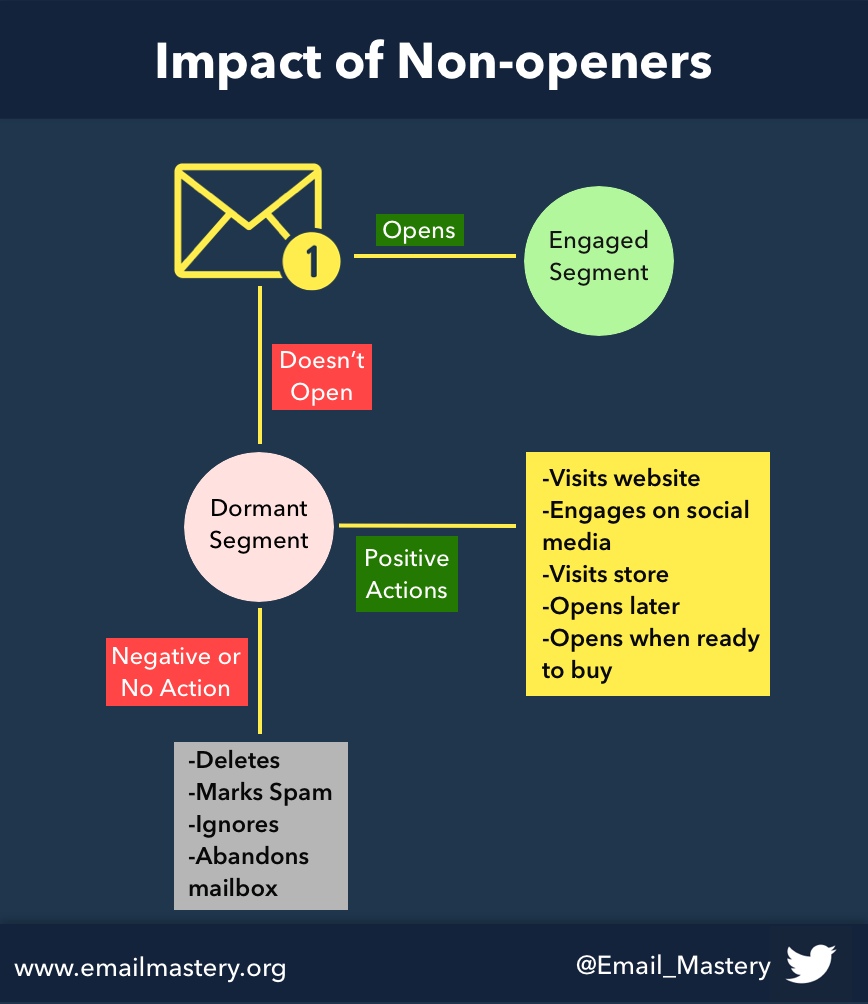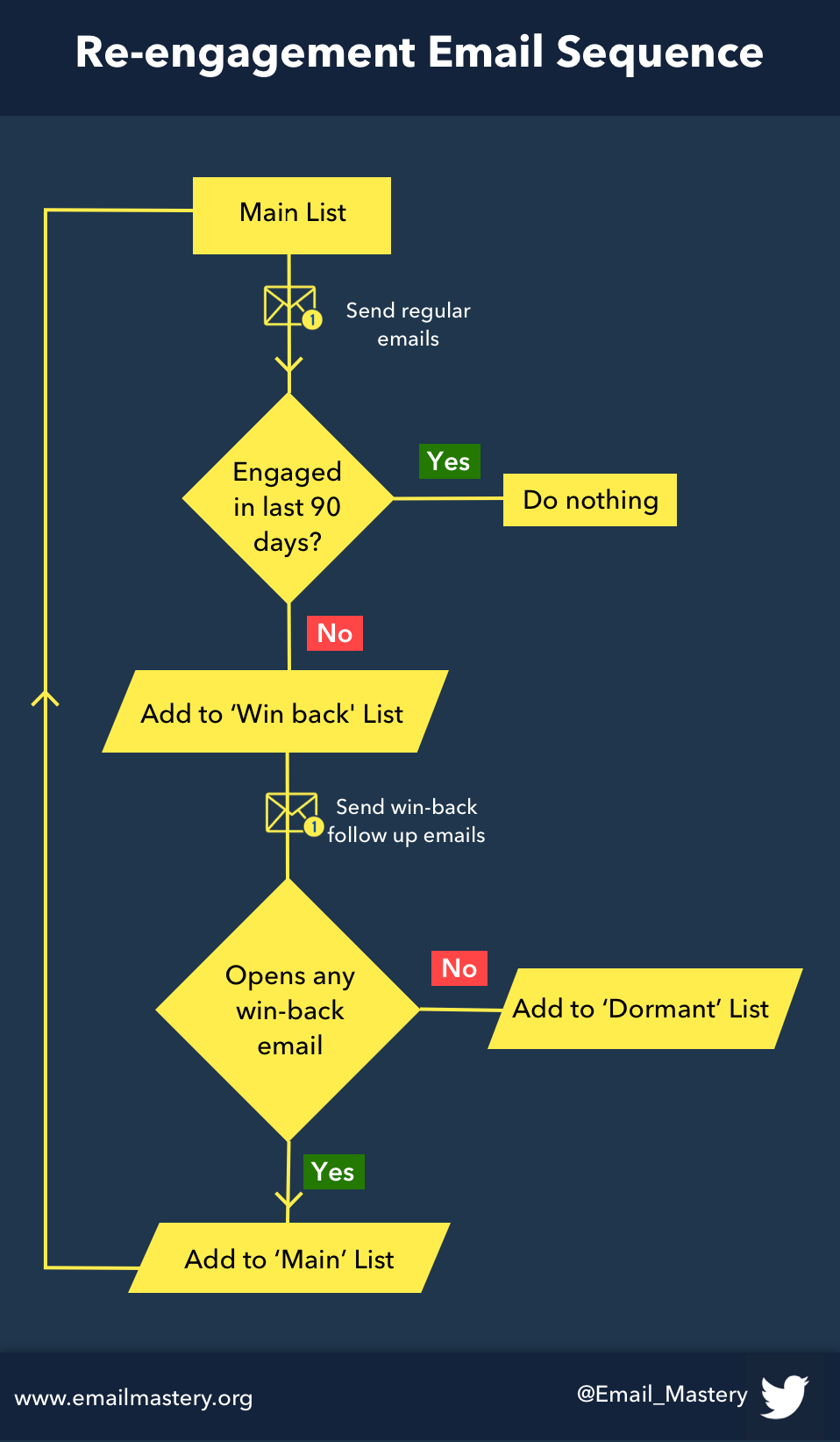You want people to engage with your emails as often as possible.
But it’s a well-known fact of email marketing that some of your subscribers, over time, will get in the habit of ignoring your emails.
It’s not necessarily because they don’t like your emails. It might be because they’re in a busy season of their lives, or because their email inbox is overstuffed, or because your subject lines aren’t catching their attention, or because you’re having deliverability problems.
The question is, how do you re-engage those dormant subscribers?
In a minute, we’ll walk you through 4 steps to doing that.
But first, it’s important to keep in mind that your list engagement rate will never be 100% — there will always be subscribers who engage consistently and subscribers who engage inconsistently. And as time passes, individuals will flip-flop between those two categories depending on a plethora of factors that you can’t control.
It’s not weird, unusual, or even bad that most of your list is dormant… it’s just something you have to be aware of and strategize for.
So the goal isn’t to delete every sub that’s currently dormant and it’s not to mindlessly entertain people at any cost… it’s simply to create a process that is always working to re-engage dormant subscribers.
By doing so, you can increase your engagement metrics and, more importantly, your sales revenue and the relationship you hold with your subscribers.
Here are the steps.
Important Note: It’s possible that you have a lot of dormant subscribers because you have a deeper deliverability problem. But if you try to fix deliverability problems with re-engagement campaigns… it won’t work. Here’s our guide to email deliverability. If you think that your emails might be going to spam, then we recommend starting there.
Step 1. Defining The Dormant Subscriber
The first thing we need to do is define what dormant subscriber means.
This will be different for every business.
Start by asking yourself, “At what point can we assume that someone has disengaged with our emails?”
“Disengaged” meaning that, for the most part, your emails are no longer on their radar. We’re trying to find people who have got in the habit of ignoring your emails.
Here are a few examples of qualifiers you can use to define “dormant” for your email list…
- Hasn’t opened an email in 6 months
- Hasn’t clicked through on an email in 6 months (this might be a better indicator that someone is close to becoming dormant. They’re still opening but they’re not clicking.)
- Hasn’t purchased a product in 6 months
Or you could use some combination of those three qualifiers — hasn’t opened, clicked, or purchased in 3 months, for instance.
However, keep in mind that the truth isn’t as simple as it seems. Let’s take a look at reasons subscribers might fall into those categories…
- They want to receive your emails but haven’t needed your product, service, or information for the last few months.
- People are viewing your email but don’t have images turned on (so your ESP isn’t reporting them as having opened).
- They don’t want your emails, but they are too lazy to unsubscribe (this is more common than you might think).
- They no longer use or check that email address (we call these “Zombie addresses”)
- They don’t see your emails because they go to the spam folder.
In other words, someone who hasn’t opened in the last 6 months might not have opened because your emails are going to their spam folder, because they’re too lazy to unsubscribe, because they no longer check that email address, because your ESP isn’t reporting accurately, or because they are just disengaged right now for one reason or another.
Similarly, people who haven’t purchased in the last 6 months might still love your brand, but not require new products right now (this is especially true if you sell high-ticket or long-lasting items).
The point is, email engagement is much more complex than many marketers think it is.

Amongst all of that uncertainty, how do you know who’s dormant for what reasons?
Well, ultimately, you don’t.
It’ll help to smooth out deliverability problems before crafting your re-engagement campaigns. It’s also important that you don’t treat open rate metrics as gospel truth since ESPs might be reporting incorrectly if subs have their images turned off.
But the primary lesson here is this: be careful about deleting email addresses.
There’s a time and place to scrub your list — when it starts to hurt your deliverability, for instance — but err on the side of trying to re-engage subscribers rather than delete them.
And always remember, unengaged with your emails does not equate to unengaged with your brand.
(Even when you do take someone off your email list, you can still try one final push toward your social media channels — maybe they’ll engage better over there — or even run a Facebook retargeting campaign… or at the very least, use them to create a lookalike audience)
Once you’ve chosen a qualifier, pull that data and see how those people are interacting with your brand. You might find, for example, that you’re still making quite a bit of money off of subscribers who haven’t opened your emails in 6 months (maybe they see your emails, delete them, and then go buy).
Or maybe you’ll find that many of the people who haven’t purchased in 6 months are very engaged with your emails and they’re just in a buying lull.
Understanding these nuances will help you craft more compelling re-engagement campaigns in Step 3.
Step 2. Creating Email Flows For Inactive Subscribers
Now you’ve defined what a dormant subscriber looks like for your business.
You also understand that there’s no perfect method for identifying why those people are dormant… but it’s still good practice to create processes and automations that work to consistently re-engage your audience.
So how do you do this?
The first step is to map out your re-engagement plan. In Step 3, we’ll talk about crafting the actual re-engagement emails, but here, we’re talking about your high-level plan.
Here are the two main questions you need to answer.
- Who qualifies as being dormant?
- What type of emails are those people going to receive?
Then grab a piece of paper and map out your email sequence. Here’s an example of what this might look like for non-openers.

And here’s an example of what this might look like for targeting non-purchasers.
Note when someone should go into the email sequence, how many emails they’re going to receive, the general direction of each of those emails (discount offer, free content, etc), and also when they should leave the sequence.
(If they open, for example, then maybe you can remove them from the re-engagement sequence)
ActiveCampaign recommends sending a “re-engagement email sequence of 3+ emails starting 30-60 days after a subscriber becomes inactive.”
Additionally, it’s a good idea to craft different re-engagement campaigns for people who haven’t opened in 3-6 months vs. people who haven’t purchased in 3-6 months… rather than treating all of those people the same.
But automated re-engagement campaigns aren’t the only way that you should treat dormant subscribers differently.
We recommend being generally aware of your dormant-subscriber segment when sending other emails as well — maybe this means using a different subject line, hook, special offer, or a different email altogether.
Whatever the case, remember that the people with a dormant-subscriber tag are going to require a little something extra to get them opening and purchasing.
Fortunately, since maintaining a clean list is in an ESPs best interest, most of them make it easy to segment subscribers based on open frequency.
For segmenting by purchase frequency, though, you’ll need to manually build out automated triggers unless your ESP integrates directly with your payment processor or eCommerce software (like Klaviyo does).
Now let’s talk about how to craft effective re-engagement emails (plus some great examples).
Step 3. Crafting Re-Engagement Email Campaigns
At this point, you’ve defined your dormant subscribers and you’ve created one or several email flows to re-engage those people.
Now it’s time to create the individual emails within those sequences.
To start, here’s some great advice from Kronda Adair at Karven Digital…
“Don’t overthink it. People have a hard time with email because they make a big deal out of it. It’s just another medium for conversation. Think of ONE person you would love to respond and write to them. My subscribers often tell me they can’t tell if my emails are personal or campaigns. Keep it simple. Sometimes a 9-word email just asking them if they’re still interested in [the benefit of your product or service] will get them to re-engage. Lastly, a little humor never hurts!” – Kronda Adair, Karvel Digital
He’s absolutely right — we don’t want to overthink this part of the process.
With your re-engagement emails, you really only have two possible goals…
- Get people opening
- Get people buying
To accomplish that, you’ll want to craft compelling subject lines, preheaders, and email content. You might also consider offering a discount or a free gift to people who take action.
Here’s an example of a great re-engagement campaign from Chime…
You’ll notice that this email has a simple flow.
- Tell the person why you’re emailing them — because they haven’t engaged recently.
- Remind the person of the service’s perks — basically, tell them why they should consider re-engaging with your brand.
- Encourage them to re-engage — this could be by offering a discount, a free gift, valuable content, or even just a friendly nudge (in this case, it’s a CTA to sign up).
Of course, assuming good deliverability, open rates basically just come down to writing effective subject lines and preheaders.
So here’s a great guide from Email Mastery about how to write effective subject lines. And here’s a great guide from them about how to write effective preheaders.
I highly recommend checking those out.
Then create your emails and start testing!
Step 4. A/B Testing To Increase Engagement
No marketing strategy is complete without a plan for testing and iterating.
So make sure that going forward, you have a plan for split testing your email campaigns based on engagement.
Easier said than done. I know.
Try doing what Morning Brew does.
Rather than leaving the engagement of their emails up to chance (and because their sponsorship business model really does depend on maintaining high open rates), Morning Brew marketers create two subject lines for each email. They then send those emails to 20% of their entire list, splitting that 20% fifty-fifty between the two emails.
Whichever subject line gets the best open rate is the one that gets sent to the other 80% of their subscribers.
This is a great ongoing tactic to make sure that you’re testing and engaging with your subscribers on a regular basis.
You should also consistently be testing different subject lines and email content within your re-engagement campaigns to determine what gets the best results. After all, since these are mostly non-openers… the goal is to get them to open.
The more you test, the more effective your re-engagement campaigns are going to become.
Conclusion
The majority of your email subscribers are dormant.
That’s not good or bad, it’s just the truth.
The best thing you can do as an email marketer, then, is to adapt to how your audience interacts with your emails… and create an automated process for re-engaging dormant subscribers.
That’s the process we’ve walked you through above.
Now it’s time to take action.
